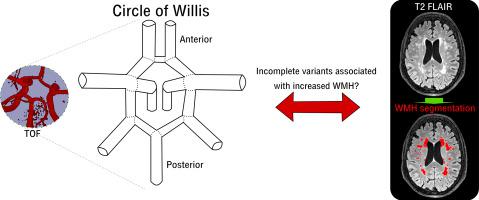当前位置:
X-MOL 学术
›
J. Neurol. Sci.
›
论文详情
Our official English website, www.x-mol.net, welcomes your
feedback! (Note: you will need to create a separate account there.)
An incomplete Circle of Willis is not a risk factor for white matter hyperintensities: The Tromsø Study
Journal of the Neurological Sciences ( IF 3.6 ) Pub Date : 2021-01-01 , DOI: 10.1016/j.jns.2020.117268 Lars B. Hindenes , Asta K. Håberg , Ellisiv B. Mathiesen , Torgil R. Vangberg
Journal of the Neurological Sciences ( IF 3.6 ) Pub Date : 2021-01-01 , DOI: 10.1016/j.jns.2020.117268 Lars B. Hindenes , Asta K. Håberg , Ellisiv B. Mathiesen , Torgil R. Vangberg

|
OBJECTIVE
The Circle of Willis (CoW) is often underdeveloped or incomplete, leading to suboptimal blood supply to the brain. As hypoperfusion is thought to play a role in the aetiology of white matter hyperintensities (WMH), the objective of this study was to assess whether incomplete CoW variants were associated with increased WMH volumes compared to the complete CoW. METHODS
In a cross-sectional population sample of 1751 people (age 40-84 years, 46.4% men), we used an automated method to segment WMH using T1-weighted and T2-weighted fluid-attenuated inversion recovery image obtained at 3T. CoW variants were classified from time-of-flight scans, also at 3T. WMH risk factors, including age, sex, smoking and blood pressure, were obtained from questionnaires and clinical examinations. We used linear regression to examine whether people with incomplete CoW variants had greater volumes of deep WMH (DWMH) and periventricular WMH (PWMH) compared to people with the complete CoW, correcting for WMH risk factors. RESULTS
Participants with incomplete CoW variants did not have significantly higher DWMH or PWMH volumes than those with complete CoW when accounting for risk factors. Age, pack-years smoking, and systolic blood pressure were risk factors for increased DWMH and PWMH volume. Diabetes was a unique risk factor for increased PWMH volume. CONCLUSION
Incomplete CoW variants do not appear to be risk factors for WMH in the general population.
中文翻译:

不完整的威利斯环不是白质高信号的危险因素:特罗姆瑟研究
目的 威利斯环 (CoW) 通常不发达或不完整,导致大脑供血不足。由于低灌注被认为在白质高信号 (WMH) 的病因学中起作用,因此本研究的目的是评估与完全 CoW 相比,不完全 CoW 变异是否与 WMH 体积增加有关。方法 在 1751 人(40-84 岁,46.4% 男性)的横断面人群样本中,我们使用自动化方法使用 3T 获得的 T1 加权和 T2 加权流体衰减反转恢复图像分割 WMH。CoW 变体是从飞行时间扫描中分类的,也是 3T。WMH 危险因素,包括年龄、性别、吸烟和血压,是从问卷和临床检查中获得的。我们使用线性回归来检查与具有完全 CoW 的人相比,具有不完全 CoW 变异的人是否具有更多的深部 WMH (DWMH) 和脑室周围 WMH (PWMH),并校正了 WMH 风险因素。结果 考虑到风险因素时,具有不完整 CoW 变异的参与者的 DWMH 或 PWMH 体积并未显着高于具有完整 CoW 的参与者。年龄、吸烟包年数和收缩压是 DWMH 和 PWMH 体积增加的危险因素。糖尿病是 PWMH 体积增加的独特危险因素。结论 在一般人群中,不完全 CoW 变异似乎不是 WMH 的危险因素。结果 考虑到风险因素时,具有不完整 CoW 变异的参与者的 DWMH 或 PWMH 体积并未显着高于具有完整 CoW 的参与者。年龄、吸烟包年数和收缩压是 DWMH 和 PWMH 体积增加的危险因素。糖尿病是 PWMH 体积增加的独特危险因素。结论 在一般人群中,不完全 CoW 变异似乎不是 WMH 的危险因素。结果 考虑到风险因素时,具有不完整 CoW 变异的参与者的 DWMH 或 PWMH 体积并未显着高于具有完整 CoW 的参与者。年龄、吸烟包年数和收缩压是 DWMH 和 PWMH 体积增加的危险因素。糖尿病是 PWMH 体积增加的独特危险因素。结论 在一般人群中,不完全 CoW 变异似乎不是 WMH 的危险因素。
更新日期:2021-01-01
中文翻译:

不完整的威利斯环不是白质高信号的危险因素:特罗姆瑟研究
目的 威利斯环 (CoW) 通常不发达或不完整,导致大脑供血不足。由于低灌注被认为在白质高信号 (WMH) 的病因学中起作用,因此本研究的目的是评估与完全 CoW 相比,不完全 CoW 变异是否与 WMH 体积增加有关。方法 在 1751 人(40-84 岁,46.4% 男性)的横断面人群样本中,我们使用自动化方法使用 3T 获得的 T1 加权和 T2 加权流体衰减反转恢复图像分割 WMH。CoW 变体是从飞行时间扫描中分类的,也是 3T。WMH 危险因素,包括年龄、性别、吸烟和血压,是从问卷和临床检查中获得的。我们使用线性回归来检查与具有完全 CoW 的人相比,具有不完全 CoW 变异的人是否具有更多的深部 WMH (DWMH) 和脑室周围 WMH (PWMH),并校正了 WMH 风险因素。结果 考虑到风险因素时,具有不完整 CoW 变异的参与者的 DWMH 或 PWMH 体积并未显着高于具有完整 CoW 的参与者。年龄、吸烟包年数和收缩压是 DWMH 和 PWMH 体积增加的危险因素。糖尿病是 PWMH 体积增加的独特危险因素。结论 在一般人群中,不完全 CoW 变异似乎不是 WMH 的危险因素。结果 考虑到风险因素时,具有不完整 CoW 变异的参与者的 DWMH 或 PWMH 体积并未显着高于具有完整 CoW 的参与者。年龄、吸烟包年数和收缩压是 DWMH 和 PWMH 体积增加的危险因素。糖尿病是 PWMH 体积增加的独特危险因素。结论 在一般人群中,不完全 CoW 变异似乎不是 WMH 的危险因素。结果 考虑到风险因素时,具有不完整 CoW 变异的参与者的 DWMH 或 PWMH 体积并未显着高于具有完整 CoW 的参与者。年龄、吸烟包年数和收缩压是 DWMH 和 PWMH 体积增加的危险因素。糖尿病是 PWMH 体积增加的独特危险因素。结论 在一般人群中,不完全 CoW 变异似乎不是 WMH 的危险因素。











































 京公网安备 11010802027423号
京公网安备 11010802027423号